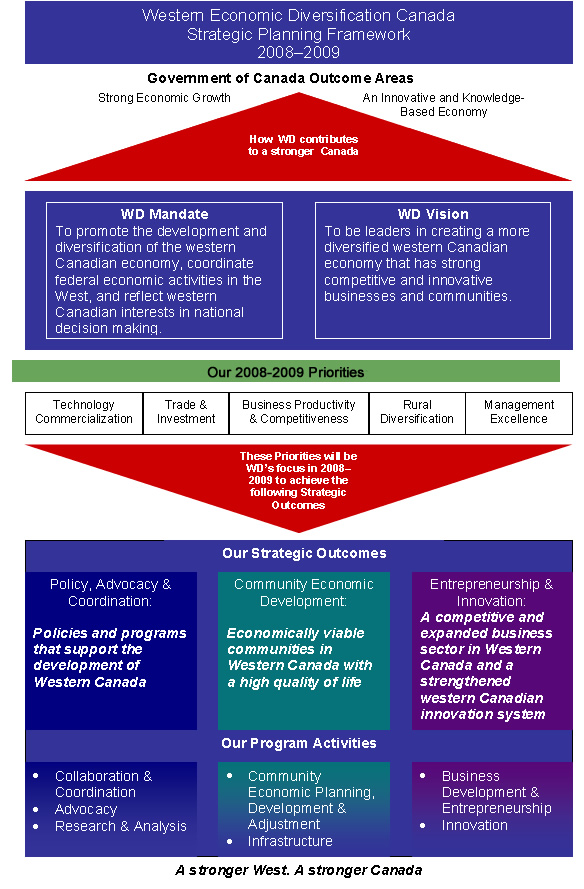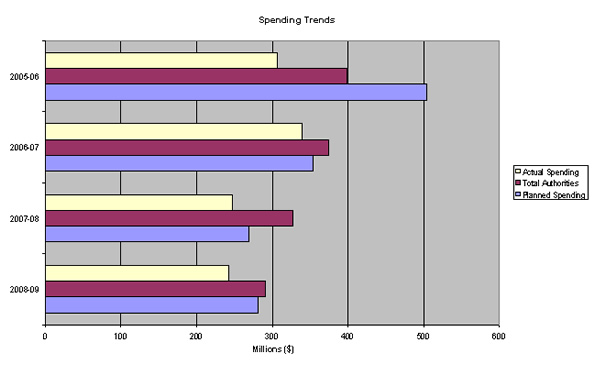Common menu bar links
Breadcrumb Trail
ARCHIVED - Western Economic Diversification Canada
 This page has been archived.
This page has been archived.
Archived Content
Information identified as archived on the Web is for reference, research or recordkeeping purposes. It has not been altered or updated after the date of archiving. Web pages that are archived on the Web are not subject to the Government of Canada Web Standards. As per the Communications Policy of the Government of Canada, you can request alternate formats on the "Contact Us" page.
Minister�s Message

As Minister responsible for Western Economic Diversification Canada (WD), I am pleased to present the Departmental Performance Report for the year ending March 31, 2009.
WD's vision is to be a leader in creating a more diversified western Canadian economy that has strong, competitive and innovative businesses and communities. In order to achieve this vision, in 2008-2009, WD focused its work on achieving results that support the department's three, interconnected strategic outcomes:
- economically viable communities in Western Canada with a high quality of life;
- a competitive and expanded business sector in Western Canada and a strengthened western Canadian innovation system; and
- policies and programs that support the development of Western Canada.
Last year, WD worked collaboratively with provincial and municipal governments, universities, research institutes, industry and not-for-profit organizations to help western communities diversify their local economies, deliver important infrastructure investments and adjust to changing economic circumstances. These close working relationships also helped ensure that WD was a strong and informed partner in the development of federal policies and programs.
Over the past year, as Canada and the world have faced an economic downturn, WD has been doing its part to support western communities. WD has helped strengthen local economies by investing in projects and activities that improve infrastructure, support local businesses, strengthen innovation and encourage community economic diversification. Moving forward, WD will continue to make investments that strengthen and diversify Western Canada's economy.
The Honourable Jim Prentice, P.C., Q.C., M.P.
Minister�s of State Message

As Minister of State for Western Economic Diversification, I am pleased to present the Departmental Performance Report for the year ending March 31, 2009.
For more than two decades, Western Economic Diversification Canada (WD) has worked to support the long-term development and diversification of the western economy, playing a vital role in helping build a stronger West and a stronger Canada. The department achieves its mandate by collaborating with other orders of government and stakeholders to identify projects that support the department's strategic outcomes and priorities.
In 2008�2009, WD approved a total of $131.3M towards 214 projects that leveraged an additional $370.6M from other governments and organizations towards projects that strengthen businesses, foster innovation and stimulate community economic development.
Western entrepreneurs and innovators are a vital source of economic growth in the West, accounting for nearly half of all existing jobs. In 2008-2009, WD approved $35.5M towards 39 projects that helped stimulate international trade and investment, enhance business productivity and competitiveness, foster industry collaboration, and improve access to services for western entrepreneurs. WD also approved $63.8M towards 50 projects designed to strengthen western innovation by improving infrastructure at our universities and research centres, developing technology skills, and supporting research and development.
WD contributed $41.8M towards 129 community economic development projects that support the long-term strength and viability of western communities. This contribution was used in the development of new businesses or industries, adding value to existing sectors, strengthening capacity, and improving local infrastructure. WD's work on community economic development also includes supporting economic recovery for communities faced with challenging economic circumstances.
The department also continued to develop effective policies and programs by increasing coordination among all partners, and effectively linking regional priorities with the federal agenda. Through our policy, advocacy and coordination activities, WD develops effective programs that create a strong and sustainable economic future for Western Canada. In addition, WD contributed $340,000 towards two projects in this area.
Now more than ever, communities across the West must strive to diversify their local economies in the face of the global recession. WD will continue to make the strategic investments necessary to help communities and strengthen local economies. With these investments and future investments under Canada's Economic Action Plan, I am confident that WD's work will continue to help Western Canada navigate through this global economic recession towards recovery and long-term prosperity.
The Honourable Lynne Yelich, P.C., M.P.
SECTION I - DEPARTMENTAL OVERVIEW
Raison d'�tre and Responsibilities
Western Economic Diversification Canada�s mandate is to promote the development and diversification of the economy of Western Canada (Manitoba, Saskatchewan, Alberta and British Columbia) and to advance the interests of Western Canada in national economic policy, program and project development and implementation.
WD supports entrepreneurship, innovation and community economic development and fulfils a leadership and coordination role in furthering western interests and responding to western challenges. The department works strategically through partnerships � with all orders of government, academic and research institutes, industry associations, and not-for-profit organizations � to implement initiatives that leverage funds and expertise for the benefit of the West and westerners.
Through its core resources, WD:
- invests in pan-western and other projects that are focused on delivering results that contribute to WD's strategic outcomes;
- supports the Western Canada Business Service Network (WCBSN), which provides more than 100 points of service in rural and urban communities across the West where entrepreneurs can get assistance in starting and growing businesses; and
- implements multi-year contribution initiatives such as the Western
Economic Partnership Agreements (WEPAs) with western stakeholders. These agreements between the Government of Canada
and the four western provinces address economic challenges by investing in shared priorities that:
- support the creation and growth of research and development (R&D), with a focus on getting new products, technologies and services out to market;
- support trade and investment;
- enhance business productivity and competitiveness; and
- increase value-added production in traditional industries.
To support national initiatives on behalf of the Government of Canada, WD also:
- delivers initiatives to mitigate the economic impact of the mountain pine beetle infestation in the Province of BC;
- works with provinces and municipalities to deliver a variety of infrastructure programs in the West, in partnership with Infrastructure Canada; and
- develops initiatives in support of Canada's Economic Action Plan, such as the Community Adjustment Fund (CAF) and the Recreational Infrastructure Canada Fund (RInC)
Strategic Outcomes and Program Activity Architecture
The diagram below summarizes WD's strategic outcomes and Program Activity Architecture, demonstrates how WD's 2008�2009 priorities contributed to achieving these outcomes, and how WD contributes to the Government of Canada outcomes areas. (For a complete listing of WD's sub-activities, please refer to Tables 11a and 11b.)

Summary of Performance
2008-2009 Financial Resources ($ thousands)
| Planned Spending | Authorities1 | Actual Spending2 |
|---|---|---|
| $281,646 | $291,214 | $242,173 |
Performance Summary Table 4
| Performance Indicators | Targets | 2008-2009 Performance |
|---|---|---|
| Real Gross Domestic Product (GDP) growth in Western Canada | 3.2% (stable growth rate) | 0.3% (2008 - decreased rate of growth) |
| Annual International Trade: value of exports excluding primary production sectors | $42.92B (increase) | $48.74B (2008 - increase) |
| R&D intensity: Gross Domestic Expenditures on R&D (GERD) as % of GDP | N/A | 1.3% (2006)5 |
| Program Activity | 2007-2008 |
2008-2009 | ||||
|---|---|---|---|---|---|---|
| Actual Spending ($000s) |
Main Estimates |
Planned Spending |
Total Authorities |
Actual Spending |
Alignment to Government of Canada Outcomes | |
| Business Development and Entrepreneurship 6 | $55,987 | $58,190 | $58,190 | $59,691 | $62,275 | Strong Economic Growth |
| Innovation 7 | $70,065 | $87,226 | $87,226 | $88,274 | $77,466 | An Innovative and Knowledge-based Economy |
| Performance Indicators | Targets | 2008-2009 Performance |
|---|---|---|
| Disposable income per capita | $31,082 (increase) | $31,933 (2008 - increase) |
| Labour productivity growth - real GDP per hour worked | 1.2% (stable growth rate) | -1.2% (2008 - decline in productivity) |
| Program Activity | 2007-2008 |
2008-2009 | Alignment to Government of Canada Outcomes | |||
|---|---|---|---|---|---|---|
| Actual Spending ($000s) | Main Estimates |
Planned Spending |
Total Authorities |
Actual Spending |
||
| Community Economic Planning, Development and Adjustment8 | $74,153 | $109,137 | $112,737 | $112,825 | $71,234 | Strong Economic Growth |
| Infrastructure 9 | $36,505 | $2,084 | $10,784 | $16,268 | $19,254 | Strong Economic Growth |
| Performance Indicators | Targets | 2008-2009 Performance |
|---|---|---|
| % of key informants with the opinion that WD activities provide policies and programs that support the economic development of Western Canada. 10 | 55% | 94% with respect to policies 93% with respect to programs |
| $'s of project funding ($'s WD project funding plus $'s leveraged) 11 | $350.04M | $513.57M (total value of all projects approved incl. amendments) |
| % of projects completed this fiscal year that successfully met or exceeded performance targets 12 | 85% | 83% (150 out of 181 projects which reported final results in 2008-2009) |
| Program Activity | 2007-2008 |
2008-2009 | Alignment to Government of Canada Outcomes | |||
|---|---|---|---|---|---|---|
| Actual Spending ($000s) |
Main Estimates |
Planned Spending |
Total Authorities |
Actual Spending |
||
| Collaboration and Coordination | $4,475 | $5,866 | $5,866 | $6,311 | $4,945 | Strong Economic Growth |
| Advocacy 13 | $3,223 | $2,683 | $2,683 | $2,999 | $3,602 | Strong Economic Growth |
| Research and Analysis | $2,752 | $4,160 | $4,160 | $4,396 | $3,397 | Strong Economic Growth |
Contribution of Priorities to Strategic Outcomes
| Operational Priorities | Type 14 | Status 15 | Link to Strategic Outcome (SO) and Program Activity (PA) |
|---|---|---|---|
| Technology Commercialization | Ongoing | Mostly met:
|
SO 1 PA - Innovation Investments in 2008-2009 will help to strengthen the western Canadian innovation system. |
| Trade and Investment | Ongoing | Mostly met:
|
SO 1 PA � Business Development and Entrepreneurship Investments in 2008-2009 will support a competitive and expanded business sector in Western Canada. One area for improvement is for WD to focus more on supporting incoming trade and investment missions as they often provide the tangible economic benefits to Western Canada. |
| Business Productivity and Competitiveness | Previously committed to | Somewhat met:
|
SO 1 PA � Business Development and Entrepreneurship Investments in 2008-2009 will also support a competitive and expanded business sector in Western Canada. |
| Rural Diversification16 | Previously committed to | Somewhat met
|
SO 1, SO 2, SO 3 Investments in 2008-2009 will support the development and diversification of the rural economy across the West, which contributes to all of WD's strategic outcomes. |
WD places a priority on Management Excellence and continues to make progress in improving management practices as encouraged through the annual Management Accountability Framework assessment.
| Management Priorities � Management Excellence | Type | Status | Link to Strategic Outcome and Program Activity (PA) |
|---|---|---|---|
| Implementation of Management, Results, and Resources, Structure (MRRS) policy | Previously committed to | Mostly met:
|
SO 1, SO 2, SO 3 Improvements to WD's MRRS support all strategic outcomes. One area for improvement is to streamline the number of sub-activities and refine the performance indicators at that level. |
| Strengthening Internal Audit and Evaluation | Previously committed to | Mostly met: Audit:
|
SO 1, SO 2, SO 3 Improvements to audit and evaluation processes support all strategic outcomes. |
| Strengthening accountability, transparency and performance reporting of WCBSN members and improved coordination | Previously committed to | Mostly met:
|
SO 1, SO 2, SO 3 Improvements in relationships with network partners support all strategic outcomes. |
| Human Resource Renewal | New | Successfully met: Planning:
Recruitment:
Strategy leadership capacity:
Enabling infrastructure:
|
SO 1, SO 2, SO 3 Human resource renewal supports all strategic outcomes. One area for improvement is to pursue the Embracing Management Excellence Forum in 2009-2010. |
| Integrated Risk Management | Previously committed to | Mostly met:
|
SO 1, SO 2, SO 3 Integration of risk with decision-making processes supports all strategic outcomes. One area for improvement is to ensure that the risk associated with proposed projects is assessed prior to any mitigation measures. |
Risk Analysis
Operating Environment
Events of 2008-2009 demonstrated that the western Canadian economy remains vulnerable to global economic fluctuations. A thriving economy and the subsequent economic downturn in mid-2008 revealed uneven levels of diversification in the West, yet also highlighted regional and sectoral economic strengths. Indeed, the rapidly changing economic picture in 2008-2009 underscored the continued need for diversification efforts in the West, as well as the importance of policy and program flexibility in response to these changes.
Opportunities
The West's abundance of natural resources serves as a traditional economic strength and ultimately the foundation for the success of the regional economy. However, dependence on resource exports and volatile commodity market prices, as demonstrated in 2008-2009, can result in unpredictable economic outcomes. As a result, WD has sought to build on the advantages associated with a strong resource-based economy while investing to create new opportunities and further develop existing opportunities.
- Technology Commercialization
- Trade and Investment
- Business Productivity and Competitiveness
- Rural Diversification
An emerging opportunity for Western Canada is in the area of technology commercialization. Guided by the Government of Canada's 2007 science and technology strategy, significant investments have been made to stimulate R&D in western Canadian universities; however, commercialization results have not been commensurate with the level of research investment. In order to facilitate the translation of knowledge and technology into commercial opportunities, WD made strategic investments in technology adoption and commercialization, and knowledge infrastructure projects, which will lead to an increase in technologies adopted by existing firms, and an increase in the number of technologies developed in research institutions that have commercialization potential. WD undertook sector research and analysis to pinpoint gaps and opportunities, as well as new programming and delivery options.
Entrepreneurship has been a pervasive feature of economic development in Western Canada, demonstrated by the high number of small- and medium-sized enterprises (SMEs), which account for nearly half of all existing jobs. Despite the significant role that trade and investment plays in job creation, a recent study of SMEs in Western Canada, "Reaching Out: Exploring SME Exporting Opportunities and Challenges", found that few SMEs export and those that do, rely heavily on a few trading partners. WD continued to support western Canadian businesses in their trade development and investment attraction efforts in connection with the Vancouver/Whistler 2010 Winter Olympic and Paralympic Games. As a departmental priority, trade and investment efforts focused on improving the international competitiveness of Western Canada and enhancing the awareness of western Canadian products, services, and technology capabilities around the world leading to increased sales, research agreements and signed contracts. These efforts were coupled with advocacy objectives centred on export market development, the Asia Pacific Gateway and Corridor, the Mid-Continent Trade Corridor, foreign trade zones, inland ports, aerospace and defence procurement, and science and technology, in order to advance western Canadian interests.
To remain globally competitive, western Canadian businesses must seek opportunities to increase overall productivity and competitiveness. To support increased business productivity, WD provided business services for SMEs - promoting awareness and adoption of new management and business practices (i.e. lean manufacturing), access to supply chains, creation of business networks, access to risk capital, and access to skilled labour.
Western Canada's rural communities continue to be highly dependent on traditional resource industries such as forestry, agriculture, mining and energy-related extraction. This dependence and the long-term trend of population out-migration may leave many communities economically vulnerable. WD continues to work with other government agencies and rural-based economic development organizations, such as the Community Futures Development Corporations (CFDC), to position rural economies for growth and diversification.Challenges
As the effects of the global economic downturn became apparent in fall 2008, the department shifted its focus to address short-term community impacts. Advocacy efforts highlighted difficult market conditions faced by Western Canada and the need for economic adjustment programming, resulting in the continuation of one program and some new programming. WD continued to assist forestry-dependent communities to recover from the effects of the mountain pine beetle infestation in British Columbia through the delivery of the Community Economic Development Initiative (CEDI) and Airport Improvement Initiative (AII). Further assistance will be provided to a variety of sectors through two new programs announced in the Government of Canada's Budget 2009: Canada's Economic Action Plan. As the regional economic development agency for Western Canada, WD undertook steps to implement two key economic stimulus programs to assist the hardest hit communities:
- CAF is a two-year $1B national program that aims to provide an economic stimulus to the economy by supporting projects that create and maintain employment. WD put in place the foundation to deliver $306 million in support to western Canadian communities hardest hit by the economic slowdown.
- RInC provides $500M nationally for projects that focus on the rehabilitation of recreational facilities across Canada. Prepratory activities following Budget 2009 have positioned WD to deliver almost $54M as part of the initial allocation to Western Canada.
Corporate Risk Profile
In 2008-2009, WD re-assessed its internal and external operating environments and prepared a corporate risk profile detailing the highest risks facing the department in fulfilling its mandate. The profile will assist in focussing attention on the key risks which impact on departmental decisions, and the need to mitigate these risks.
Expenditure Profile

Fluctuations in expenditures over the past four years can be attributed to the transitory nature of non-core transfer payment programs. In addition to core transfer payment programs, WD manages a series of one-time initiatives, such as the Mountain Pine Beetle Program initiatives, Alberta and Saskatchewan Centenaries , and International Vaccine Centre's Biosafety Level III Containment Facility in Saskatoon, which respond to the needs of western Canadians at any given time. The winding down of prior initiatives and the launch of new initiatives can result in fluctuations in spending from year to year. For example, grant funding was $47.0M for 2006-2007, $18.5M in 2007-2008 and nil in 2008-2009, due to the wind down of the Prince Rupert Port Authority, Primrose Lake Air Weapons Range, BC Flood Mitigation and Fraser River Port Authority initiatives, which were funded through grants. The figures presented in the above chart do not include funds spent through Other Government Department (OGD) suspense accounts, on behalf of other departments. For example, in fiscal year 2008-2009, WD expended approximately $125M on behalf of Infrastructure Canada.
| Vote or Statutory Item ($000s) | Truncated Vote or Statutory Wording | 2006-07 Actual Spending |
2007-08 Actual Spending |
2008-2009 Main Estimates |
2008-2009 Actual Spending |
|---|---|---|---|---|---|
| 1 | Operating expenditures | $41,494 | $45,018 | $48,753 | $49,645 |
| 5 | Grants and contributions | $292,591 | $197,120 | $215,271 | $187,009 |
| (S) | Contributions to employee benefit plans | $4,917 | $5,017 | $5,322 | $5,481 |
| (S) | Collection Agency Fees | $3 | - | - | |
| (S) | Minister of Western Economic Diversification | $5 | $25 | ||
| (S) | Spending of Proceeds from disposal of Surplus Crown Assets | $2 | $2 | - | $13 |
| Total | $339,009 | $247,160 | $269,346 | $242,173 |
